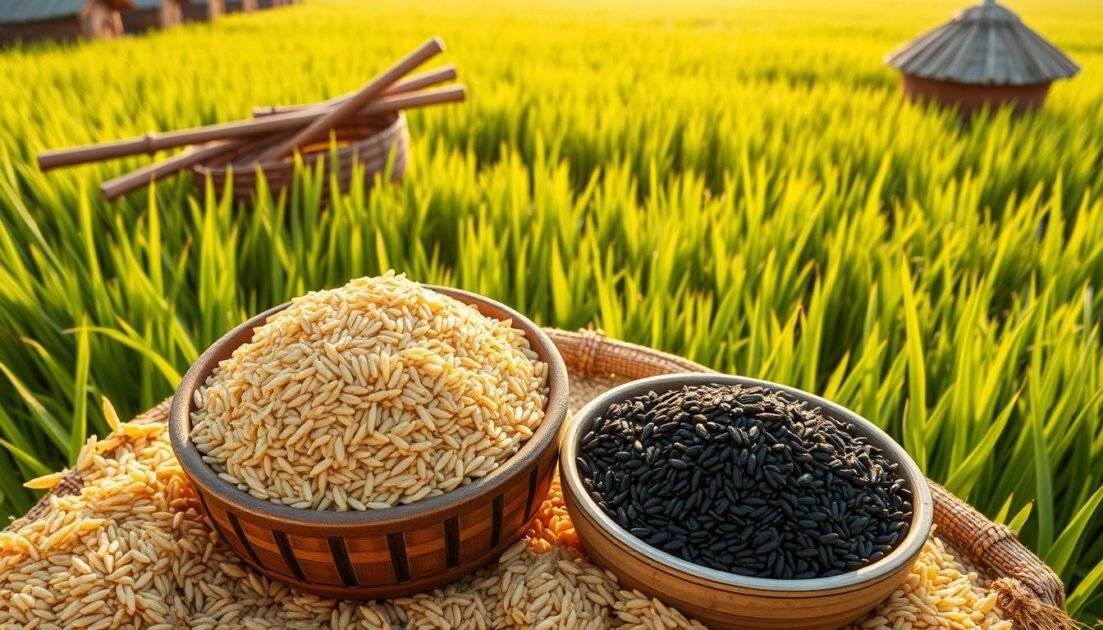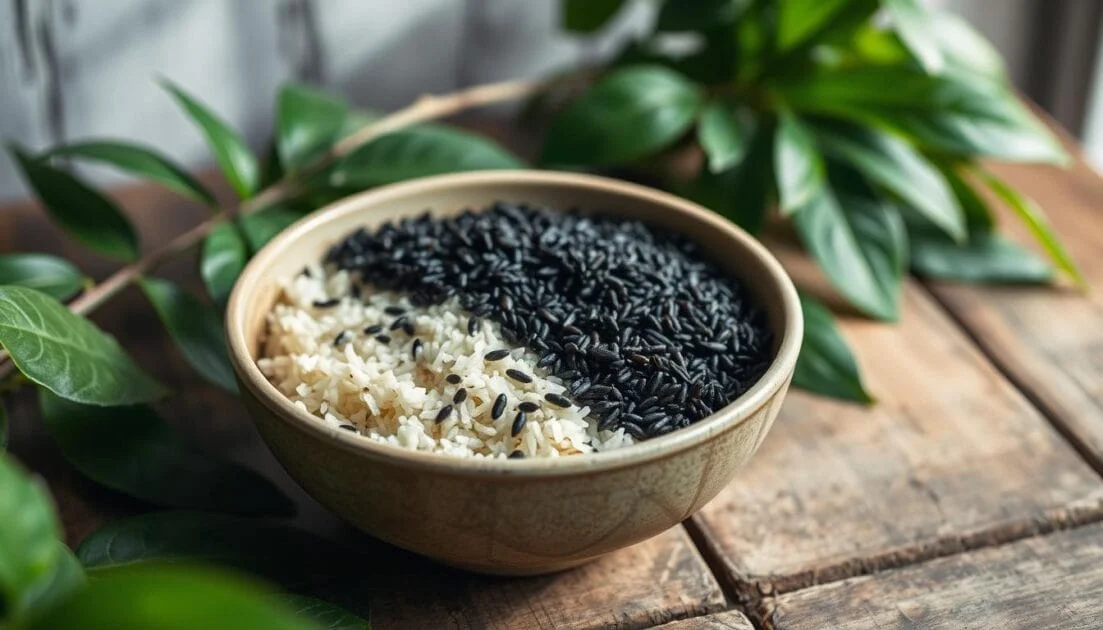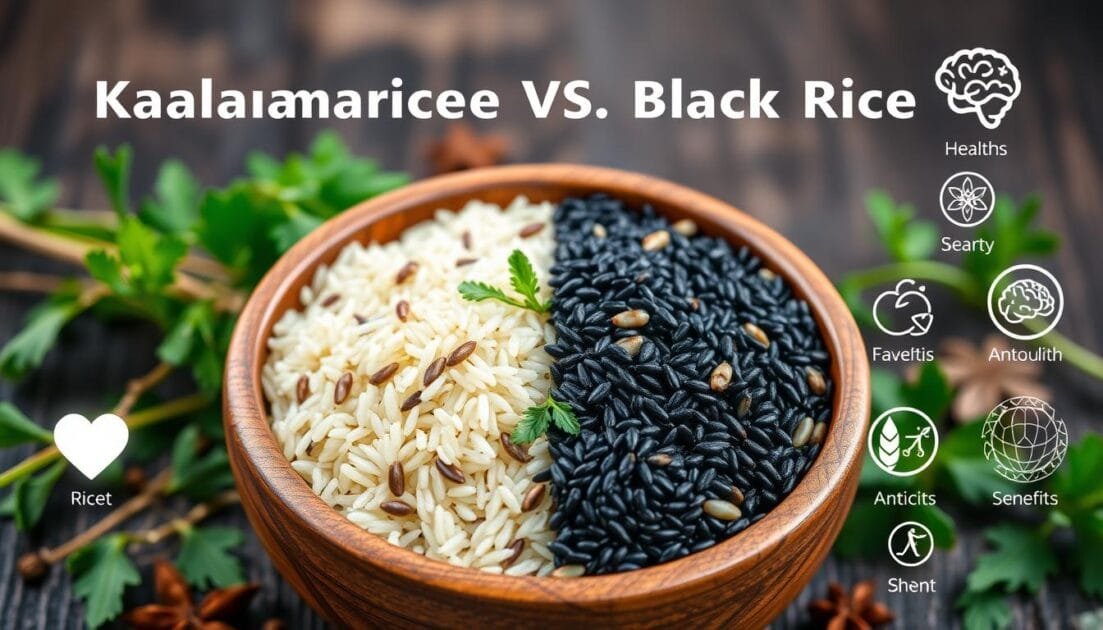Table of Contents[Hide][Show]
- Physical Characteristics and Appearance Comparison
- Low Glycemic Index rice, Buy Low GI Rice, Kalanamak Rice
- Health Benefits and Medicinal Properties
- Storage Guidelines and Shelf Life
FAQ+−
- Is kalanamak rice and black rice the same?
- What are the origins and historical significance of kalanamak and black rice?
- How do kalanamak and black rice differ in their physical characteristics and appearance?
- What are the key nutritional differences between kalanamak and black rice?
- How can kalanamak and black rice be cooked and incorporated into various dishes?
- What are the potential health benefits and medicinal properties associated with kalanamak and black rice?
- Where can one source authentic kalanamak and black rice varieties, and how do their prices compare?
- How should kalanamak and black rice be stored to maintain their quality and shelf life?
Many people get confused between “kalanamak rice” and “black rice.” But these two types of rice are not the same. They come from different places and have different uses in cooking. Let’s explore what makes them unique.
Kalanamak rice is known as the “Basmati of the East.” It’s grown in Nepal’s Terai region and India’s Gangetic plains for centuries. It’s famous for its strong smell, long grains, and deep purple color. On the other hand, black rice, also called “forbidden rice,” comes from Asia, like China and India. Both have a deep color, but they come from different places and have different genes.

Key Takeaways
- Kalanamak rice and black rice are distinct rice varieties with unique origins and properties.
- Kalanamak rice is a prized variety from the Terai region of Nepal and the Gangetic plains of India, known for its aroma, long grains, and deep purple hue.
- Black rice, or “forbidden rice,” is a unique variety that originated in parts of Asia, including China and India.
- While both share a deep pigmentation, their genetic lineages and growing regions differ significantly.
- Understanding the differences between these ancient rice varieties is crucial for appreciating their diverse culinary applications and nutritional benefits.
Understanding Kalanamak and Black Rice Varieties
Kalanamak and black rice are two special types of rice with a rich history in India. They have been grown for centuries, each with its own story.
Origins and Historical Significance
Kalanamak rice, known as the “Black Pearl of India,” comes from the Terai region of Uttar Pradesh. It has been grown in the Himalayas’ foothills for generations. Its dark color and unique taste make it a favorite in local cooking.
Black rice, a group of rice types, has also been grown in India for centuries. Varieties like Chakhao and Manipuri black rice were used in traditional ceremonies. They show the cultural importance of these grains.
Traditional Growing Regions
- Kalanamak rice is mainly grown in the Terai region of Uttar Pradesh, especially in Basti, Gorakhpur, and Siddharthnagar.
- Black rice varieties, like Chakhao from Manipur and Manipuri black rice, are grown in northeastern India. This includes Manipur, Assam, and Nagaland.
Cultural Importance in Indian Cuisine
Kalanamak and black rice are key to Indian cooking. Kalanamak rice is used in dishes like biryani and pulao, adding flavor and beauty. Black rice is used in festive foods, adding color and nutrition to traditional recipes.
| Rice Variety | Traditional Cultivation Regions | Culinary Applications |
|---|---|---|
| Kalanamak Rice | Terai region of Uttar Pradesh | Biryani, Pulao, Khichdi |
| Black Rice | Northeastern states (Manipur, Assam, Nagaland) | Festive preparations, Traditional recipes |
“Kalanamak and black rice have been revered for their unique flavors and cultural significance, woven into the very fabric of India’s culinary heritage.”
Physical Characteristics and Appearance Comparison
Explore the world of Kalanamak and black rice. We’ll look at their unique looks and how they taste. These grains are not just for eating; they also delight the eyes.
Kalanamak rice has a long, slender shape. It’s black and smells amazing. Black rice is bigger and darker. It looks like royalty.
| Characteristic | Kalanamak Rice | Black Rice |
|---|---|---|
| Grain Shape | Slender, elongated | Broad, robust |
| Color | Deep, inky black | Stunning ebony |
| Aroma | Captivating, earthy | Nutty, slightly sweet |
| Texture | Soft, silky | Firm, slightly chewy |
Both Kalanamak rice and black rice have special grain structures. Kalanamak is delicate, while black rice is sturdy. Their looks and feel make them special in cooking.
“Kalanamak and black rice are not just staple grains – they are edible works of art, each grain a masterpiece in its own right.”
Whether you love Kalanamak rice or black rice, they offer a unique taste journey. They will impress your taste buds and touch your heart.
Nutritional Profile: Kalanamak vs Black Rice
Kalanamak and black rice are more than just different types of rice. They are packed with nutrients and offer many health benefits.
Protein and Fiber Content
Both Kalanamak and black rice are great for protein and fiber. Kalanamak has about 6-7 grams of protein per 100 grams. Black rice has around 8 grams per 100 grams. They also have good amounts of fiber, with Kalanamak having 3-4 grams per 100 grams and black rice having 4-5 grams per 100 grams.
Antioxidant Properties
Kalanamak and black rice are known for their high antioxidant levels. They contain anthocyanins, which are powerful antioxidants. Black rice has up to 20 times more antioxidants than white rice.
Mineral Composition
| Mineral | Kalanamak Rice | Black Rice |
|---|---|---|
| Iron | 2.5 mg/100g | 3 mg/100g |
| Magnesium | 25 mg/100g | 35 mg/100g |
| Zinc | 1.8 mg/100g | 2.2 mg/100g |
Kalanamak and black rice are also rich in important minerals like iron, magnesium, and zinc. They have more of these nutrients than white rice.
“The unique nutritional profiles of Kalanamak and black rice make them true superfoods, offering a wealth of health benefits to those who incorporate them into their diets.”
Low Glycemic Index rice, Buy Low GI Rice, Kalanamak Rice
The type of rice you eat can affect your blood sugar levels. Kalanamak rice, a traditional Indian variety, is known for its low glycemic index. This makes it great for people with diabetes or those who want to control their carb intake.
The glycemic index shows how fast a food raises your blood sugar. Kalanamak rice is digested slowly, causing a gradual increase in blood sugar. This is different from high GI foods, which can cause quick spikes and drops in blood sugar.
Adding low GI rice like Kalanamak to your meals has many benefits:
- It helps manage blood sugar levels better, making it a diabetic-friendly choice.
- It gives you sustained energy, keeping you full and satisfied for longer.
- It may lower the risk of chronic diseases like type 2 diabetes and heart disease.
If you want to enjoy the benefits of low GI rice, try Kalanamak. It’s a real option that’s easy to find. Make it a key part of your blood sugar management plan.

Cooking Methods and Preparation Techniques
Kalanamak rice and black rice have similar cooking methods. But, each type has its own special way to get the best taste and texture. Whether you’re making traditional dishes or trying new recipes, learning how to cook these rices is crucial.
Traditional Cooking Instructions
To cook Kalanamak rice, first rinse it well. Then soak it in water for 30 minutes to an hour. This step removes impurities and makes the rice softer.
When it’s time to cook, use 1 cup of rice to 2 cups of water. Bring the mix to a boil, then lower the heat and simmer for 18-20 minutes. The rice should be tender and the water absorbed.
Black rice needs a different method. Rinse the grains and cook them in 1:2 rice-to-water ratio. Simmer for 25-30 minutes. This brings out its deep, nutty flavor and firm texture.
Modern Culinary Applications
- Kalanamak rice is great for pilafs, risottos, and even desserts like rice pudding. It’s versatile in both savory and sweet dishes.
- Black rice adds a unique taste and look to sushi, salads, and grain bowls. It’s perfect for health-conscious and visually appealing meals.
- Both types can be used in many Kalanamak rice recipes and black rice cooking tips. Try them in stir-fries, curries, and as a base for vegetable or protein-rich dishes.
| Cooking Method | Kalanamak Rice | Black Rice |
|---|---|---|
| Soaking Time | 30-60 minutes | Not required |
| Rice-to-Water Ratio | 1:2 | 1:2 |
| Cooking Time | 18-20 minutes | 25-30 minutes |
| Texture | Tender, fluffy | Firm, chewy |
| Culinary Uses | Pilafs, risottos, desserts | Sushi, salads, grain bowls |
“Cooking Kalanamak and black rice is an art, requiring patience and attention to detail. The rewards, however, are well worth the effort – rich, flavorful grains that elevate any dish.”
Health Benefits and Medicinal Properties
Kalanamak rice and black rice are not just tasty. They also have many health benefits and medicinal uses. These special types of rice help keep you healthy and can even help with certain health problems.
One great thing about Kalanamak and black rice is their low glycemic index. This makes them perfect for people with diabetes. The slow carbs in these rice types help keep blood sugar steady, avoiding big ups and downs.
These rice types are also full of antioxidants, especially anthocyanins. These antioxidants fight inflammation. Eating Kalanamak and black rice can help lower inflammation. This is good for many chronic diseases, like arthritis and heart disease.
| Health Benefit | Kalanamak Rice | Black Rice |
|---|---|---|
| Diabetes Management | ✓ | ✓ |
| Anti-inflammatory Effects | ✓ | ✓ |
| Antioxidant Protection | ✓ | ✓ |
| Digestive Health | ✓ | ✓ |
Kalanamak and black rice are also full of vitamins, minerals, and fiber. They are great for a healthy, balanced diet. Adding these rice types to your meals can boost your overall health and well-being.
“Kalanamak and black rice are not only delicious but also packed with powerful health benefits. These unique rice varieties can be game-changers in your journey towards better wellness.”

Price Points and Market Availability
Finding authentic Kalanamak rice and black rice is key. Knowing the prices and where to find them is important. These rice types are loved for their health benefits and unique tastes. This has made them more popular in the rice market.
Where to Source Authentic Varieties
Finding real Kalanamak and black rice can be hard. They mainly grow in certain parts of India. Look for specialty rice stores, health food shops, or online stores that sell rare rice. Local farmers’ markets and organic food stores might also have these rice types.
Price Comparison Analysis
The cost of Kalanamak rice and black rice changes based on where you buy it. A 1-kilogram bag of Kalanamak rice costs between ₹200 to ₹400. Black rice prices are usually ₹150 to ₹300 per kilogram. The higher prices often mean organic, high-quality grains from small farmers.
| Rice Variety | Average Price Range (per kg) |
|---|---|
| Kalanamak Rice | ₹200 – ₹400 |
| Black Rice | ₹150 – ₹300 |
Prices can change due to supply, demand, and shipping costs. Keeping up with market trends and where to buy can help you make smart choices when buying Kalanamak rice or black rice.
Storage Guidelines and Shelf Life
Keeping Kalanamak and black rice fresh is key for those who love rice. To keep their nutritional value and taste, it’s important to store them right. This means using the best storage methods.
For storing, use airtight containers or food-grade plastic bags. This keeps air, moisture, and pests out. It helps the rice stay fresh longer. Store the rice in a cool, dry spot, away from sunlight and heat.
Check the rice often for signs of spoilage. Look for color changes or bad smells. Proper storage keeps the rice’s health benefits and taste. This way, you can enjoy Kalanamak and black rice for a long time.
FAQ
Is kalanamak rice and black rice the same?
No, they are not the same. Kalanamak rice and black rice have different qualities and uses.
What are the origins and historical significance of kalanamak and black rice?
Kalanamak rice comes from ancient India, mainly from the Himalayas. Black rice, also from Asia, is known for its dark color and health benefits.
How do kalanamak and black rice differ in their physical characteristics and appearance?
Kalanamak rice has long, slender grains and a unique smell. Black rice is dark purple or black, thanks to its anthocyanin.
What are the key nutritional differences between kalanamak and black rice?
Kalanamak rice is good for blood sugar control. Black rice is full of antioxidants, fiber, and minerals, offering health benefits.
How can kalanamak and black rice be cooked and incorporated into various dishes?
Cook them by boiling or steaming. Use them in dishes like biryani, risotto, salads, and desserts. They add special flavors and textures.
What are the potential health benefits and medicinal properties associated with kalanamak and black rice?
Kalanamak rice may help with inflammation and diabetes. Black rice is full of antioxidants, which could lower disease risks.
Where can one source authentic kalanamak and black rice varieties, and how do their prices compare?
Find them at specialty stores, online, or from producers. Prices change based on availability, demand, and shipping costs.
How should kalanamak and black rice be stored to maintain their quality and shelf life?
Store them in airtight containers in a cool, dry place. Keep them away from sunlight and moisture to keep them fresh longer.

 what are the health benefits of kalanamak rice?
what are the health benefits of kalanamak rice?